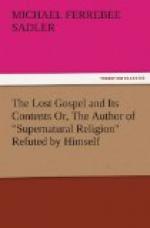“Therefore these words testify explicitly that He is witnessed to by Him Who established these things [i.e. the Father] as deserving to be worshipped, as God and as Christ.” (Dial. lxiii.)
The reader will find other declarations, most of which are equally explicit, in Dial. ch. lvi. (at the end), ch. lvii. (at the end), lxii. (middle), lxviii. (at middle and end), lxxiv. (middle), lxxv., lxxvi. (made Him known, being Christ, as God strong and to be worshipped), lxxxv. (twice called the Lord of Hosts), lxxxvii. (where Christ is declared to be pre-existent God), cxiii. (he [Joshua] was neither Christ, Who is God, nor the Son of God), cxv. (our Priest, Who is God, and Christ, the Son of God, the Father of all), cxxiv. (Now I have proved at length that Christ is called God), cxxv. (He ministered to the will of the Father, yet nevertheless is God), cxxvi. (thrice in this chapter), cxxvii., cxxviii., cxxix.
[73:1] I adopt this phrase because, it is used by Justin. His words are [Greek: arithmo onta heteron]. (Dial. ch. lxii.)
[74:1] [Greek: Hoti archen pro panton ton ktismaton ho Theos gegenneke dynamin tina ex heautou logiken, k.t.l.]
[77:1] Dr. Pusey translates this passage thus:—“For all that the philosophers and legislators at any time declared or discovered aright, they accomplished according to their portion of discovery and contemplation of the Word; but as they did not know all the properties of the Word which is Christ,” &c.
[77:2] Translated by Dr. Pusey, “Seminal Divine Word.”
[78:1] A few pages further on I shall show that the mode of reasoning adopted by the author of “Supernatural Religion,” in drawing inferences from the ways in which Justin expresses the idea of St. John’s [Greek: ho logos sarx egeneto] would, if we adopted it, lead us to some very startling conclusions.
[84:1] The following are some instances:—“God sent not His Son into the world to condemn the world.” “He Whom God sent.”—John iii. 17, 23. “My meat is to do the will of Him that sent me.” “Jesus Christ, Whom Thou hast sent.” “As my Father sent me, so send I you,” &c.
[85:1] This passage does not occur among the remarks upon Justin Martyr’s quotations, but among those on the Clementine Homilies. However, it seems to be used to prove that the Gospel of St. John was published after the writing of the Clementines, which the author seems to think were themselves posterior to Justin.
[86:1] I say the “necessary” developments, because Holy Scripture is given to the Church to be expounded and applied, and in order to this its doctrine must be collected out of many scattered statements, and stated and guarded, and this is its being developed. The Persons, the attributes, and the works of the three Persons of the Godhead are so described in Holy Scripture as Divine, and They are so conjoined in the works of Creation, Providence, and Grace, that we cannot but contemplate Them as associated together, and cannot but draw an impassable gulf between Their existence and that of all creatures, and we cannot but adoringly contemplate Their relations one to another, and hence the necessary development of the Christian dogma as contained in the Creeds.




